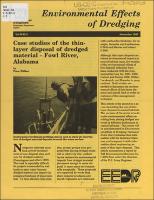Please use this identifier to cite or link to this item:
https://hdl.handle.net/11681/4270Full metadata record
| DC Field | Value | Language |
|---|---|---|
| dc.contributor | Dredging Operations Technical Support Program (U.S.) | - |
| dc.contributor.author | Wilber, Pace | - |
| dc.date.accessioned | 2016-03-16T17:34:20Z | - |
| dc.date.available | 2016-03-16T17:34:20Z | - |
| dc.date.issued | 1992-11 | - |
| dc.identifier.uri | http://hdl.handle.net/11681/4270 | - |
| dc.description | Information Exchange Bulletin | - |
| dc.description | Introduction: Navigation interests must find several thousand acres of new disposal sites each year for dredged material (Francingues and others 1985). This task is especially difficult for projects surrounded by wetlands or open water because dredged material can impair the ecological functions of these habitats. To help alleviate this situation, several groups have proposed that placing dredged material in relatively thin, uniform layers reduces the environmental impacts from dredged material placement enough to make disposal in some areas environmentally acceptable. These proposals are supported by works that show impacts to infauna and marsh vegetation are correlated with overburden thickness, for example, Zaremba and Leatherman (1984) and Maurer and others (1986). Although thin-layer disposal can reduce environmental impacts in several habitat types, few studies of the environmental effects of this disposal technique have been conducted (TAI Environmental Services Inc. 1987, 1988, Cahoon and Cowan 1988, Wilber, Luczkovich, and Knowles in preparation). Such studies are needed to document the environmental effects of thin-layer disposal and should lead to wider acceptance of this management technique. This article is the second in a series chronicling the use of thin-layer disposal in coastal habitats. The purpose of the series is to describe environmental effects resulting from placing dredged material at different thicknesses in coastal habitats. This series will be complemented by Environmental Effects of Dredging Technical Notes that synthesize this information with the technical literature and integrate it with information about engineering aspects of thin-layer disposal. This article summarizes a report by TAI Environmental Services Inc. (1987) done under the direction of the U.S. Army Engineer District, Mobile that examined an estuarine area in Mobile Bay, Alabama, up to one year after dredged material was placed on the bay bottom in a layer that generally ranged from 15 to 60 centimeters thick. | - |
| dc.publisher | Environmental Laboratory (U.S.) | - |
| dc.publisher | Engineer Research and Development Center (U.S.) | - |
| dc.relation | http://acwc.sdp.sirsi.net/client/en_US/search/asset/1044148 | - |
| dc.rights | Approved for public release; distribution is unlimited. | - |
| dc.source | This Digital Resource was created from scans of the Print Resource | - |
| dc.subject | Dredging | - |
| dc.subject | Dredging spoil | - |
| dc.subject | Dredged material | - |
| dc.subject | Spoil banks | - |
| dc.subject | Dredged material disposal | - |
| dc.subject | Environmental aspects | - |
| dc.subject | Environmental effects | - |
| dc.subject | Fowl River | - |
| dc.subject | Alabama | - |
| dc.subject | Environmental monitoring | - |
| dc.subject | Case study | - |
| dc.title | Case studies of the thin-layer disposal of dredged material : Fowl River, Alabama | - |
| dc.type | Report | en_US |
| Appears in Collections: | Bulletin | |
Files in This Item:
| File | Description | Size | Format | |
|---|---|---|---|---|
| VOL-D-92-5.pdf | 5.04 MB | Adobe PDF |  View/Open |